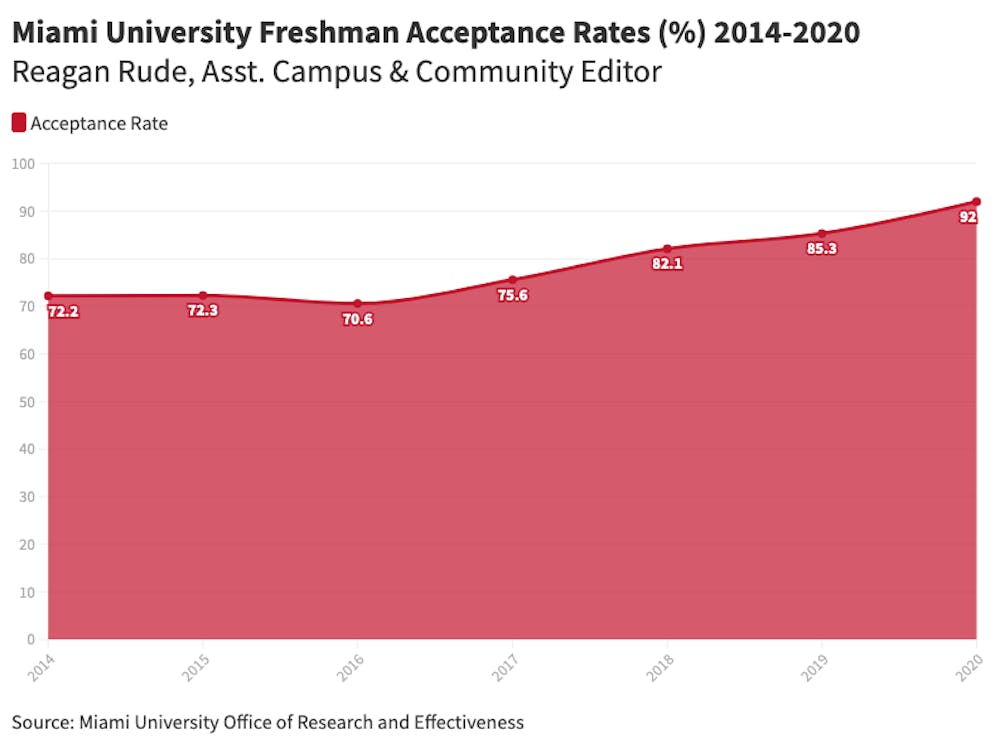For the class of 2022, Harvard University had a 4.59% acceptance rate. The chances for prospective college students looked better if they applied to Ohio State University, settling in at 52%. Ohio University’s main campus was close to guaranteed admission, with a rate of 87%.
Miami University’s admissions rate?
For applicants looking it up on Google, they’ll find it listed at 92% on Collegedunia.com, the first search result.
The rate is up from 74.6% in 2018, but university officials say that doesn’t necessarily reflect the current rate of acceptance at Miami.
Bethany Perkins, assistant vice president and director of admissions at Miami, explained that the number reflected the high rate of acceptance during the COVID-19 pandemic — it has not been updated on most websites to reflect new numbers.
“We had to work pretty aggressively to meet our class numbers in fall 2020 due to COVID,” Perkins said. “There were a number of factors that impacted the high admission rate in 2020 that we didn’t necessarily see in future years, including this past fall.”
Although the 92% acceptance rate shown online may not be accurate for this academic year, some students worry it will bring down Miami’s Public Ivy reputation.
Alex Wieland-Ducher is a senior studying chemistry at Miami. He was accepted in 2019, when the acceptance rate was close to 80%. He wasn’t happy with the perceived increase in acceptance rate. He said the rate may not affect Miami now, but could in the future.
“Miami’s reputation is not going to be immediately influenced, but I see [the rates] being an issue for people, say, two years down the line,” Wieland-Ducher said. “It’s going to take some lag time to really be seen by people, but for people that would be accepted anyway in the future, they are definitely going to have some issues.”
For Campbell Ryall, a high school senior from Minnesota, the high acceptance rate actually encouraged her to apply to Miami.
“I guess [the acceptance rate] would be nice since I know that [Miami] would most likely be a safety school for me,” Ryall said. “It’s like it would be a for-sure option in case I didn’t get into any of the other schools I’ve applied to.”
Enjoy what you're reading?
Signup for our newsletter
Ryall said online acceptance rate didn’t greatly influence her opinion of Miami. She placed greater importance on the programs a college offers.
“I think [acceptance rate] is important, but not as important as the individual programs themselves,” Ryall said. “For example, Indiana University has over a 50% acceptance rate — the Kelley School of Business there has such a good reputation, but it’s not a school with a ten percent acceptance rate or anything.”
Daryl Zazycki, a first-year mathematics major, said Miami was not his first pick, but he still decided to come after being rejected from three of his four top schools, and the fourth one being too expensive.
Zazycki doesn’t view the seemingly high acceptance rate as reflective of the Miami he’s experienced so far, though.
“Honestly, [the acceptance rate] doesn’t seem like it should be that high,” Zazycki said. “In my biased brain, compared to other schools that have similar acceptance rates, we seem a lot better.”
Brent Shock, the vice president of Enrollment Management and Student Success at Miami, agreed that Miami’s acceptance rate does not reflect the quality of its education..
Still, he said it was important to make sure the acceptance rate was reported accurately.
“I think it’s a number that actually gets more attention than it should, but I do think that because people assign an incorrect meaning to that number that it’s a number that we just have to naturally watch and pay attention to,” Shock said.
Wieland-Ducher disagrees.
“I don’t like [the higher rates] that much,” Wieland-Ducher said. “COVID has hit everyone, but it’s two years on, we don’t really need to be that coddling anymore. I can understand admissions being rather [lenient] for the first year or maybe two, but if it gets past that we’re going to have an issue.”
Wieland-Ducher, whose mother used to work as a professor at Miami, said more students coming to Miami could have a negative toll on staff. The result, he said, could be a worse learning environment and burnt out professors.
Overall, Shock said he isn’t too concerned about the university’s reputation. Plus, acceptance rates don’t equal enrollment numbers.
“I think [acceptance rate] is a silly number, if that makes sense,” Shock said. “It’s a silly number because people assign meaning to it, but it does not equal prestige and it does not equal the strength of the institution.”




